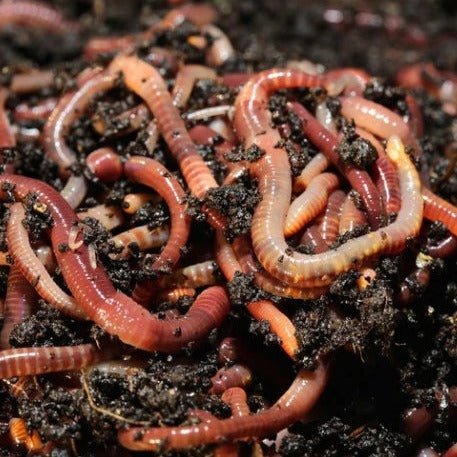The Secret to Lush Lawns Starts with Red Wiggler Express Lawn Care Services
The Secret to Lush Lawns Starts with Red Wiggler Express Lawn Care Services
Blog Article
Red Wigglers: The Unsung Heroes of Organic Waste Recycling
Red wigglers, or Eisenia fetida, offer as important agents in the natural waste recycling procedure, changing discarded products right into valuable vermicompost. Their effective breakdown of raw material not only boosts dirt high quality but additionally adds to sustainable waste administration methods. As the globe increasingly seeks solutions to deal with waste build-up and improve farming performance, recognizing the role of these worms comes to be essential. What systems allow them to flourish in garden compost settings, and how can they be effectively utilized in both household and business setups? Checking out these concerns discloses the more comprehensive ramifications of vermicomposting in our ecological landscape.
What Are Red Wigglers?
The impressive resilience of red wigglers, medically referred to as Eisenia fetida, emphasizes their vital duty in organic waste recycling. These tiny, reddish-brown earthworms are typically discovered in disintegrating raw material, such as garden compost piles and manure loads. Lake Hickory Bait. Unlike various other earthworm species, red wigglers thrive in nutrient-rich environments and are very effective at breaking down natural products, making them essential for vermicomposting

(Red Wiggler Express)In enhancement to their duty in waste decrease, red wigglers add to dirt health and wellness by enhancing dirt framework and oygenation with their delving activities (Lake Hickory Bait). Their existence in composting systems not only enhances decay prices yet also advertises a lasting approach to waste management, illustrating their relevance in ecological preservation initiatives
Advantages of Composting With Worms
Composting with worms, especially red wigglers, offers countless advantages that improve both waste monitoring and soil wellness. First, these worms efficiently break down organic waste, transforming it into nutrient-rich vermicompost that enriches soil. This procedure increases decomposition, enabling a much faster recycling of cooking area scraps and other organic products compared to typical composting approaches.
In addition, the vermicompost generated by red wigglers is teeming with beneficial microbes, which assist improve dirt framework, oygenation, and moisture retention. This improves the total wellness of plants, promoting energetic growth and raised yields in gardens and agricultural setups. The use of worms in composting minimizes the manufacturing of greenhouse gases, such as methane, contributing to a more lasting waste administration system.

How to Begin Vermicomposting
Establishing a vermicomposting system is an uncomplicated process that can produce considerable advantages for both waste management and dirt enrichment. To start, pick a suitable container, such as a plastic bin or wood box, with ample air flow openings to ensure appropriate air flow. The measurements need to ideally be about 2 feet by 3 feet, enabling enough room for the worms to flourish.
Next, prepare bed linens product, which can include shredded newspaper, cardboard, or coconut coir. This bedding needs to be moistened to develop a suitable environment for the worms. Once the bed linens remains in location, introduce red wigglers (Eisenia fetida) right into the container, normally around one pound of worms for every single square foot of area.
Adhering to the positioning of worms, include natural waste, such as fruit and veggie scraps, coffee premises, and smashed eggshells. With these steps, you will properly start a vermicomposting system that adds to sustainable waste monitoring and improves your dirt.
Keeping a Healthy And Balanced Worm Container
(Red Wiggler Express)Maintaining a worm bin prospering calls for regular attention and treatment to make sure the wellness of the red wigglers and the effectiveness of the composting procedure. Correct upkeep begins with keeping track of the dampness levels; the bin ought to perspire yet not waterlogged. A good policy of thumb is to keep an uniformity similar to a wrung-out sponge.
Carefully blending the bed linens and food scraps every few weeks protects against compaction and makes sure that all worms have access to oxygen. In addition, it is vital to feed the worms suitably.
Temperature level Discover More Here policy is another important element. Red wigglers flourish in a variety of 55 to 77 levels Fahrenheit. If the container ends up being as well warm or cold, the worms might end up being stressed out - Lake Hickory Bait. Occasionally check for signs of wellness, such as worm population development and the existence of healthy and balanced castings. By diligently managing these variables, one can maintain a durable and effective worm container.
Effect On Sustainable Living
The successful upkeep of a worm container not only benefits the health of red wigglers yet additionally contributes substantially to sustainable living practices. By reusing natural waste, such as cooking area scraps and lawn debris, red wigglers help draw away considerable amounts of material from garbage dumps. This reduction in waste not just reduces greenhouse gas emissions yet also decreases the ecological concern associated with waste monitoring.
Additionally, the spreadings produced by red wigglers serve as a nutrient-rich organic fertilizer, improving soil health and promoting plant growth. This natural alternative to chemical plant foods supports sustainable agriculture and gardening methods, minimizing dependence on synthetic inputs that can damage communities. In addition, worm composting fosters understanding of waste administration, urging people and areas to take on even more lasting habits.

Conclusion
In summary, red wigglers work as important contributors to organic waste recycling via their reliable disintegration of organic products. Their ability to produce nutrient-rich vermicompost boosts soil wellness and sustains lasting agricultural techniques. By integrating vermicomposting right into waste management approaches, individuals and communities can dramatically minimize waste while advertising ecological sustainability. The function of Eisenia fetida in cultivating healthy and balanced communities underscores the relevance of these microorganisms in accomplishing lasting living and improving soil fertility.
Report this page